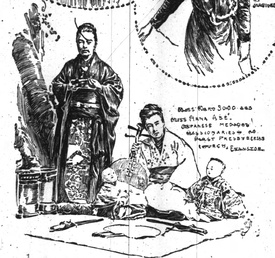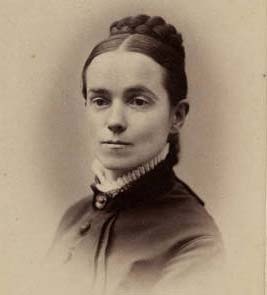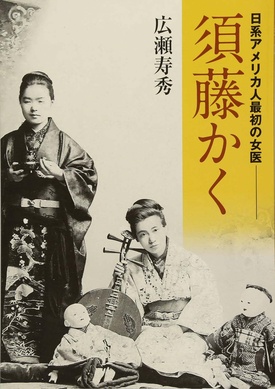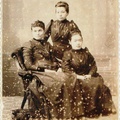Visit to America
Kaku Sudo, Hana Abe, and Dr. Kelsey set out for America from Yokohama in 1891. First, they went to Kelsey’s home in Camden, NY by riding the transcontinental railroad from San Francisco after 2 weeks of Pacific line sailing from Yokohama. Kelsey’s mother, Amanda, passed away in 1871. Her father Asa was healthy, even though he was 90-years old. He had been busy in agriculture and activities of Republic and Church.
Fairport is a city located near Rochester New York, 120km from Camden, where Kelsey’s brother, Samuel lived. Dr. Kelsey thought it is better for Kaku and Hana to first learn American culture, habits, manner, and language in Fairport, rather than on a rural farm in Camden. Kaku and Hana then entered the electropathy school in Philadelphia, and then they entered the Laura Memorial Woman’s Medical College of the Presbyterian hospital in Cincinnati on the next year of arrival to the U.S.

The medical school in Cincinnati cost them $2500, corresponding to $70,000 now. To cover the tuition, Kaku and Hana decided to make a tour introducing Japanese culture. They visited over 22 states to give lectures and collect donations. Dr. Kelsey also sold the arts and crafts, which were gifted from her patients in Japan to support their tuition. These art works, lacquer crafts, armor, sword, and paintings that Dr. Kelsey sold are now preserved at Mount Holyoke College and the Cincinnati Art Museum.
Kaku and Hana graduated from Laura Memorial College in March 1896, and later interned at the ophthalmology of Dr. Holmes’s hospital because great number of Japanese had diseases of the eye, many being afflicted with blindness. Kaku, Hana, and Dr. Kelsey returned to Yokohama in November 1897.
Yokohama Ladies Charity Association Hospital
When Kaku and Hana returned to Japan, they soon submitted an application for a Japanese medical license. However, they could not get the license because Laura Memorial Woman’s Medical College was not accepted as an official school because it was recently founded in 1986 and new to the Japanese officials. At that time, women must graduate from a foreign official medical school to become a doctor. Dr. Kelsey asked for help from the U. S. Ambassador to Japan and the Minister. Because of her efforts, Kaku and Hana at last were granted Japanese doctor licenses in March 1898. Their license numbers were fifty-fourth for Hana Abe and fifty-fifth for Kaku Sudo.
In August 1892, Kaku’s former classmate at the Yokohama Kyoritsu Women’s college, Waka Ninomiya and Yasu Hishikawa, who graduated from the Woman’s Medical College of Chicago in 1889, founded Yokohama Ladies Charity Association Hospital (Negishi Hospital). Kaku, Hana, and Dr. Kelsey started to work at Negishi Hospital because Yasu had to move to Kyoto.
The Negishi Hospital operated with the donations by the Ladies Charity Association members, but gradually they suffered financial difficulties. Dr. Kelsey would have liked to run an American style charity hospital which could provide medical care to people lived in poverty by free or small fee under the Christian spirit; however, she could not achieve this goal due to the financial difficulties of the Negishi Hospital.

Meanwhile, Dr. Kelsey opened the sanatorium in Nikko for the missionaries who were injured and escaped the Boxer Rebellion of China and cared for them1. However, the medical missionary itself gradually became obsolete in Japan. She couldn’t get much help from WUMS (Women's Union Missionary Society) and became tired of working as a medical missionary, even if she had high ambitions, which was to provide medical care to the poor. Kelsey, who had health issues, decided to retire and return to the United States since she already had her successors: Dr. Sudo and Abe.
For Kaku and Hana, Dr. Kelsey was not only a beloved teacher, but “companion,” who connected though their faith. When they heard that Kelsey would return to the United States, they also decided to go to U.S. with her despite the Yokohama Ladies Charity Association and others who held them up. In 1902, Kaku and Hana went to the United States with Dr. Kelsey in 1902 after stopping all medial activities in Japan.
Their Life in the U.S.
When Kaku went to the United States, another three Japanese went with her— Kaku’s younger sister Mayu’s husband Narita Yosokichi (37 years old), and two of his eldest children, Maya (15 years old) and Koichi (10 years old). They were called for helping Kelsey’s father’s farm in Camden, New York. Kaku thought it was a great opportunity to give her niece and nephew an American education. Yosokichi also has three other daughters: Katsu (8 years old), Ren (5 years old), and Sue (1 years old ), but they were too young and remained with their mother Mayu in Japan.
In 1907, Dr. Kelsey and Abe came back to Japan and tried to bring the rest of Yosokichi’s family to the United States. At the port of Seattle, however, Mayu was diagnosed with epidemic trachoma. She alone was sent back to Japan. Mayu passed away in Japan without seeing her children in U.S. again.
At Camden, they had lived together like a family and had a happy and devout life. They taught neighborhood children and treated them if somebody got sick. Unfortunately, Hana Abe passed away in February 1911 at the age of 44 with tuberculosis after they shared their lives for 30 years. Her death greatly affected Dr. Kelsey and Sudo.
In 1922, Kelsey sold her family farm in Camden and moved to Saint Cloud, Florida with Kaku and Yosokichi’s family. Dr. Kelsey passed away peacefully there at the age of eighty-seven in 1922. Yosokichi also passed away at the age of eighty-one in 1946.
Kaku’s pension was cut off in 1933 due to her “non-American citizenship” status, even though she had lived in the U.S. for over 30 years. Such cruel treatment hurt her deeply, but she couldn’t do anything about it and she engaged in local church activities enthusiastically. Kaku got her U.S. citizenship at the age of ninety-two in July 1953. She was one of the first Japanese who became naturalized. She said:
“I have always lived with American people—even in Japan as a child. I love them—I like the way they live. I feel closer to them than to my own race. I have lived in America the greater part of my life—yet, I am not an American....I have just one regret—I’m not American. I feel like an American—I live in America. I love the country. It is my home. My nephew gave up his life for its principles2. My one hope is that I may die—an American”. (The Orland Sentinel, April 16, 1952)

On June 4, 1963, Kaku’s long life ended peacefully at the age 102 with Yosokichi’s second daughter Katsu (Jean) and her husband Jorge Yoshida at her side. Her grave is in Mountain Cemetery, Saint Cloud.
* * * * *
Kaku Sudo was born at the end of the samurai period when women’s education mainly focused on literacy at terakoya. She went up to Tokyo to learn English at the age 10 and studied in the United States at the age 30, and graduated from the medical school at 35 years old. The distances between Aomori and Tokyo as well as Yokohama and America were much farther than now. Being 10 years old was too young for deciding one’s future; the age 30 was too late for studying abroad, considering the time was when women usually got married around 20 years old.
Furthermore, women being denied their rights and racial discrimination was strongly persistent in the U.S. at that time. Even if she had support from Kelsey, her life wasn’t easy and it must have been hard for her to study medicine in English.
I admire her courage to overcome the hardships through the Meiji Restration and World War II, despite there being many handicaps, such as distance, age, gender, language, and economic status, which are still big barriers even at the present time.
On the other hand, Kaku had received the best education for a women at that time. She was expected to serve as a great medical doctor and teacher in Japan, but went to the U.S. without any hesitation when Dr. Kelsey decided to retire and return home. She had been with Kelsey until her final moments and had never gone back to Japan. I am deeply touched her grace, kindness, and sympathy.
Kaku Sudo was an unknown woman in Japan, even in Aomori prefecture because she had worked only a short time as a doctor in Japan. Through my research via Japanese resources as well as American newspapers, I was able to connect dots of her life. She was a strong women who had good faith and confronted with the era with great courage. Kaku became a pioneer of independent and active women.
Notes:
1. WUMS left many documentations of the medical missions in China, but had a little fund for missionary activities in Japan. Dr. Kelsey gathered funds for treatments as well as living and returning expenses for the wounded at the Boxer Rebellion by using the newspapers.
2. She was referring to her neice's son, Kenjiro Yoshida, who was killed in Italy 1944. He was in the famous 442nd Infantry Regiment.
© 2021 Toshihide Hirose





